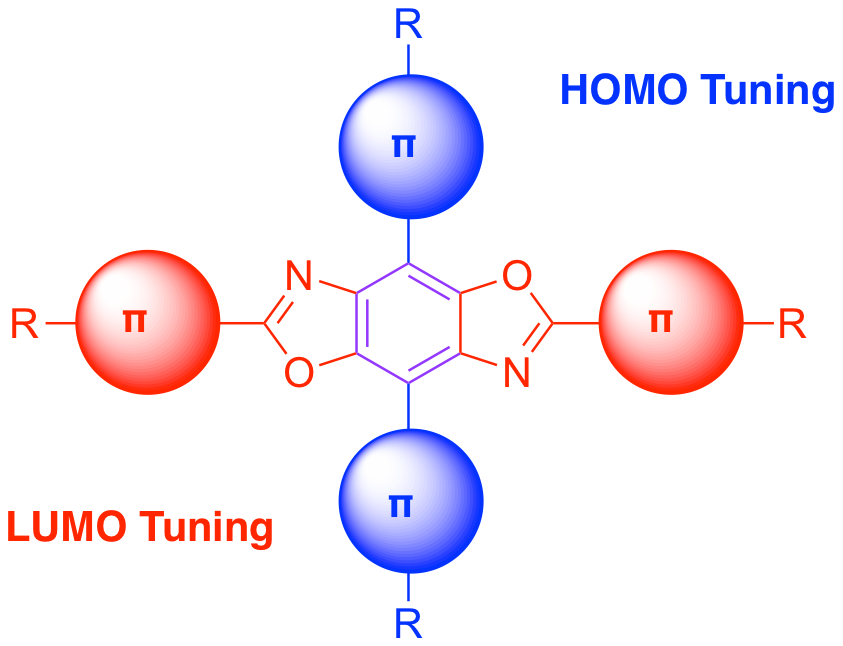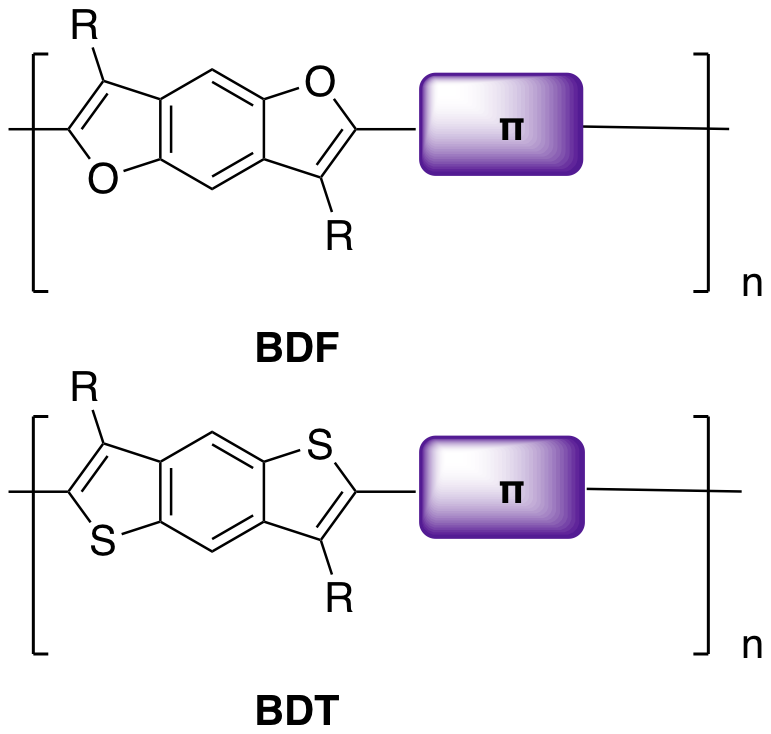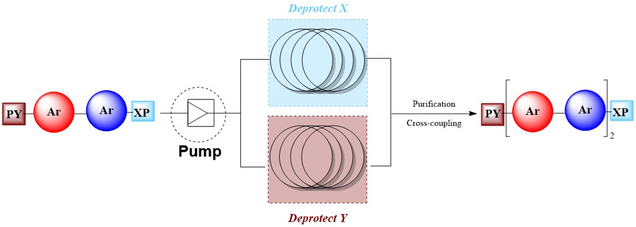Current Projects
Synthesis of cross-conjugated benzobisoxazoles
 Benzo[1,2-d:4,5-d′]bisoxazoles (BBO)s are promising electron-deficient heterocycles for use the development of new polymers due to their near-planar structure which can facilitate efficient packing and charge transport. Materials based on them have exceptional electronic, optical and thermal properties and thus are ideally suited for diverse organic semiconducting applications. BBO-based systems are unique in that they have two conjugation pathways, one along the 2,6-axis that encompasses the two oxazole rings and a second along the 4,8-axis that goes through the central benzene ring. This structure allows for synthesis of number of cross-conjugated materials with properties that are readily tuned by substitution. Using a combination of organic synthesis, theoretical calculations and physical measurements we are systematically investigating the structure property relationships within these systems. The work has produced wide band-gap blue-light emitting materials for use in OLEDs and narrow band gap cruciform with energy levels suitable for use in OSCs. This project is supported by the NSF Division of Chemistry, CHE-1640298 (1413173).
Benzo[1,2-d:4,5-d′]bisoxazoles (BBO)s are promising electron-deficient heterocycles for use the development of new polymers due to their near-planar structure which can facilitate efficient packing and charge transport. Materials based on them have exceptional electronic, optical and thermal properties and thus are ideally suited for diverse organic semiconducting applications. BBO-based systems are unique in that they have two conjugation pathways, one along the 2,6-axis that encompasses the two oxazole rings and a second along the 4,8-axis that goes through the central benzene ring. This structure allows for synthesis of number of cross-conjugated materials with properties that are readily tuned by substitution. Using a combination of organic synthesis, theoretical calculations and physical measurements we are systematically investigating the structure property relationships within these systems. The work has produced wide band-gap blue-light emitting materials for use in OLEDs and narrow band gap cruciform with energy levels suitable for use in OSCs. This project is supported by the NSF Division of Chemistry, CHE-1640298 (1413173).
Synthesis of novel materials based on benzodichalogenophenes (BDC)s
 Based on successful the ring annulation chemistry developed by Richard Larock, our group has been developed an efficient route for the synthesis of substituted benzo[1,2-b:4,5-b’]difuran (BDF). This electron-rich building block is easily synthesized in a few high yielding steps from low-cost starting materials; readily customizable enabling a number of structural modifications; and isoelectronic to benzo[1,2-b:4,5-b’]dithiophene. The later, has been combined with various electron-deficient co-monomers for the synthesis of copolymers with excellent performance in organic solar cells (OSC)s. Due to the differences in the electronic structure of BDF, its performance in OPVs is expected to exceed that of the sulfur analog. We are currently evaluating the impact of atomic engineering on the materials properties by performing structural modifications on the basic polymer structure are also proposed to improve film formation, pi-stacking and charge transport. Concurrently, we will evaluate the physical, optical, and electronic properties of the materials through spectroscopic measurements and performance in OSCs. This project is supported by the NSF Division of Materials Research, DMR-1640297 (1410088).
Based on successful the ring annulation chemistry developed by Richard Larock, our group has been developed an efficient route for the synthesis of substituted benzo[1,2-b:4,5-b’]difuran (BDF). This electron-rich building block is easily synthesized in a few high yielding steps from low-cost starting materials; readily customizable enabling a number of structural modifications; and isoelectronic to benzo[1,2-b:4,5-b’]dithiophene. The later, has been combined with various electron-deficient co-monomers for the synthesis of copolymers with excellent performance in organic solar cells (OSC)s. Due to the differences in the electronic structure of BDF, its performance in OPVs is expected to exceed that of the sulfur analog. We are currently evaluating the impact of atomic engineering on the materials properties by performing structural modifications on the basic polymer structure are also proposed to improve film formation, pi-stacking and charge transport. Concurrently, we will evaluate the physical, optical, and electronic properties of the materials through spectroscopic measurements and performance in OSCs. This project is supported by the NSF Division of Materials Research, DMR-1640297 (1410088).
Synthesis of conjugated oligomers in flow
Flow microreactors have emerged as a promising new synthetic method for both lab scale and industrial chemists. Microreactors have several advantages over traditional batch methods such as enhanced heat transfer, safety when performing exothermic or toxic reactions, precise control of resonance or reaction time, high throughput, and high surface to volume ratio. As a result, the use of flow reactors has been used to optimize a variety of pharmaceutical processes. Therefore, it is our intention to utilize a platform that is familiar in biology and medicinal chemistry to investigate a variety of carbon-carbon bond forming techniques, and apply them using flow chemistry to generate well-defined, oligomeric materials of varying molecular weight. The overall objective is to identify trends in conjugation length to gain a deeper understanding of effective conjugation and how it effects both optoelectronic and film forming properties in a variety of materials.